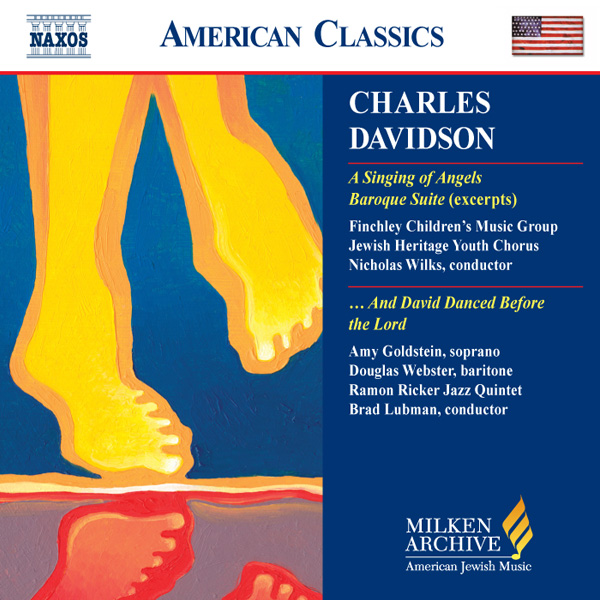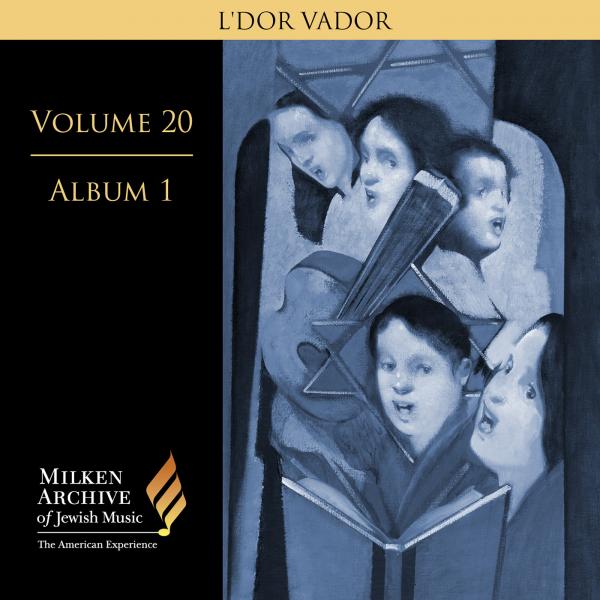Tracks
Track |
Time |
Play |
| III. Courante (Halomi) | 02:19 | |
| IV. Sarabande (Et shimkha l'varekh) | 02:19 | |
| V. Minuet (Kol kokhve voker) | 01:43 | |
| VI. Fugue (Helki adonai) | 02:21 |
Liner Notes
Charles Davidson's Baroque Suite (published with the Hebrew subtitle as well: Naḥalat Adonai Banim) might be viewed as a stylized Hebraic echo of WesternBaroque musical idioms. Like A Singing of Angels, it was commissioned by the Beth Abraham Youth Chorale, which gave its premiere in Dayton, Ohio, in 1976. To this observer, who has conducted the work many times with various youth choruses for general as well as Jewish audiences, it has always seemed as if Davidson’s original conception might have been inspired not only by the magnificence and soaring lyricism of Yehuda Halevi’s poetry, but equally so—whether consciously or subliminally—by a sort of cultural-historical fantasy that could follow from a series of hypothetical questions: What if more than a small handful (at most) of self-proclaimed Jews had been able to participate as composers in the mainstream of western music during the Baroque era? What if, as in 20th-century America, some of those imagined composers had devoted a part of their gifts to Judaic expression as high art or on a universal plane? What if a body of Judaically related but nonliturgical choral music from that period, interpreting some of the great traditions of Hebrew poetry up to that time, had thus come down to us? And what if Jewish, and especially Hebrew, musical expression therefore formed a part of the aggregate Western Baroque canon—a constituent of our composite Baroque repertoire?
Yehuda Halevi (ca. 1075–1141) is universally regarded as one of the greatest of the medieval Spanish Hebrew poets who flourished in what is now often identified as the Golden Age of Spanish/Iberian Jewry. And to the general public today he is probably the most widely recognized exemplar of that artistic tradition. He was also an important philosopher, remembered for his seminal polemical work, Sefer ha-Kuzari, which he wrote in Arabic; and he was a physician who served royalty and nobility.
Much of Halevi’s poetry is informed by a philosophical concept he formulated in the Kuzari: a fourfold unity that embodies an inextricable relationship among God (as the God of the people Israel and, as master of the universe, of all peoples); the people Israel, to whom truth was revealed through the Scriptures; the Land of Israel (eretz yisra’el), which he called the “Gate of Heaven”; and the Hebrew language itself, as the language both of prophecy and of the people Israel. His verse is often filled with passionate love and yearning associated with those intertwined aspects of Jewish existence and expression.
There are about 800 known poems by Halevi, secular as well as religious and quasi-religious. They embrace the following basic categories: love poetry; eulogies and laments; piyyutim—liturgical poems inserted into the regular liturgy; personal lyric poetry; and “songs,” or hymns to Zion, which swirl with longing for the Land of Israel and all it signifies historically and spiritually for the Jewish people. Those approximately thirty-five shirei tziyon (Songs of Zion) contain some of his most famous poems, such as Libbi b’mizraḥ (My Heart Is in the East); Y’fe nof (Fair Vista); and ḥalomi (My Dream), which Davidson set for the third movement of this suite.
In the poems Davidson selected for the second and third movements, Halevi incorporated and juxtaposed biblical verses from Psalms, Song of Songs, Numbers, and the Prophets. The poems for movements IV–VII are entirely original. They are all nonliturgical in function, in the sense that they are not additions to worship services. Nonetheless, they are deeply religious, invoking an intense love for God and between God and the people Israel, and celebrating that special and often misunderstood spiritual relationship.
Baroque Suite is a stylistic musical composite, loosely modeled on various—and mostly early—Baroque formal and harmonic features. And in a sense it is a fusion of Baroque vocal and instrumental elements, since it is a manifestly choral work whose form is nonetheless patterned after the quintessentially Baroque instrumental dance suite. Its succession of movements comprises a series of individual pieces in contrasting stylized dance rhythms typical of many such suites: a stately chorale, a courante, a sarabande, and a minuet—all introduced by a prelude (solely instrumental here) and followed by a Baroque-style fugue, an intrada, and an aria, rather than concluding with a gigue as do so many late Baroque suites. There are also traces of late Renaissance choral writing, where interpolated homophonic passages or short sections deviate briefly from the established rhythmic pattern of a movement and from its otherwise continuous polyphonic flow. Mild allusions to late Renaissance textures may also be discerned in the relative similarity and equality of independent voice parts in some sections. But overall the counterpoint here is governed in Baroque fashion by a harmonic scheme and by a series of harmonic chord progressions that are defined in the harpsichord accompaniment—a trait that separates the choral style of this work from the more independent a cappella polyphony of the Renaissance.
Baroque Suite also makes modest reference to the typical Baroque representation of various affections—“states of the soul,” such as excitement, grandeur, contemplation, exaltation, agitation, loftiness, or wonderment—through its sharply contrasting expositions. The resulting appositions among the movements in spirit, rhythm, and tempo create the desired tension throughout. This tension between opposing moods and between lyric expression and more disciplined order, as well as between contrasting affections, is emblematic of the Baroque and its departure from more conservative emotional detachment in music of the preceding period.
Reliance on patterns of strictly measured and regular rhythms in this suite also follows Baroque practice. But, almost in contrast to this metrical strictness, the vocal lines mirror the expansive lyricism of the poetry where appropriate. This too might be viewed within the contextual framework of a duality that is often associated with the Baroque.
The idiomatic use of harpsichord as the primary accompanying instrument echoes a familiar Baroque sonority. Its bass line, or sometimes other pitches central to the voice leading, is reinforced by the cello, much as in the typical Baroque basso continuo practice. The flute adds yet another Baroque association, especially in its contrapuntal obligato passages. In his harmonic language, as well as in both vocal and instrumental idioms, Davidson maintains that he sought deliberately to evoke an early Baroque style (ca. 1580–1630), particularly in its Italian phase.
The following movements have been excerpted for this recording:
III. Courante
In stylized presentation, this dance form is a regular feature of late Baroque abstract instrumental suites (i.e., not necessarily functional dance music, although it also appeared as early as the 15th century in music to accompany actual dance). Johann Jakob Froberger (1616–67) is generally reputed to have established the courante as a standard component of dance suites. In this movement of the Baroque Suite, the choral entry, which presents a theme in G major that is repeated and then developed, is preceded by a gracious instrumental introduction. Halevi’s words appear to have been inspired by the text of Numbers 24:5 (ma tovu ohalekha ... / How lovely are your tents of dwelling), which often forms the opening prayer in many contemporary synagogue services. That biblical passage was also the source for Brahms’s “How Lovely Is Thy Dwelling Place” in his German Requiem.
IV. Sarabande
This slow dance form was also fixed as a standard suite movement by Froberger. It was common practice for such Baroque masters as Handel, Corelli, and Bach to utilize in their works well-known and even popularly recognizable tunes. Davidson followed that practice in this movement by quoting, with slight variations and modulations, such tunes found in actual Baroque-era works. The poem asserts God’s knowledge of each person even before he was created, and it takes the form of a plea to God to guard the poet while he sleeps and to awaken him so that he may worship and praise God’s name.
V. Minuet
Halevi’s poem, titled “Morning Hymn,” or “Hymn to the Morning,” depicts the splendor of the early morning stars as they fade into the brightening sky during sunrise. For religiously observant Jews in former times, those morning stars served as an indication to those who stood watch during the night that the time for morning prayers had come. Davidson reflects this with a simple theme in F major, which is repeated and then developed to the movement’s conclusion.
In highly stylized form, all three of these dance forms—the minuet, the sarabande, and the courante—along with others such as the allemande and the gigue—were brought to their artistic zenith in Bach’s suites and partitas.
VI. Fugue
This fugal movement is reminiscent of imitative contrapuntal techniques and idioms of the Baroque. Halevi’s poem proposes that only those who serve God are truly free, while “servants of time will become slaves to time.” This movement begins with a three-part fugato in C major, its modest development soon interrupted by a chorale. The fugal treatment of the subject is then continued, concluding with another chorale section and a coda.
The published score includes, in addition to the transliterated Hebrew text underlay, a singable English adaptation by the composer. Davidson has acknowledged in his preface, however, that the simplicity of Halevi’s style in the original Hebrew is elusive, so that no English rendering can approach the poet’s “inspired choice of words” and stylistic mastery.
Lyrics
Sung in Hebrew
III. COURANTE: ḤALOMI (MY DREAM)
My God, Thy dwelling places are lovely!
It is in vision and not in dark speeches that Thou art near.
My dream did bring me into the sanctuaries of God,
And I beheld His beautiful services;
And the burnt offering and meal offering and drink offering,
And round about, heavy clouds of smoke.
And it was ecstasy to me to hear the Levites’ song,
In their council for the order of services.
I awoke, and I was yet with Thee, O God,
And I gave thanks, and it was sweet to thank Thee.
IV. SARABANDE: ET SHIMKHA L'VAREKH (WAKE ME TO BLESS MY NAME)
Thou didst know me before Thou hadst formed me,
And so long as Thy spirit is within me, Thou keepest me.
Have I any standing ground if Thou drive me out?
Is there any going forth for me if Thou restrain me?
And what can I say, since my thought is in Thine hand?
And what can I do until Thou help me?
I have sought Thee: in a time of favor answer me,
And as with a shield, gird me round with Thy grace.
Raise me up to seek early Thy shrine;
Wake me to bless Thy name.
V. MINUET: KOL KOKHVEI VOKER (MORNING HYMN)
All the stars of morning sing to Thee,
For the radiance of their shining is of Thee;
And the sons of God, standing by the watches
Of night and day, glorify the glorious name;
And the company of saints receive the word from them,
And every dawn, wake early to seek Thine house.
VI. FUGUE: ḤELKI ADONAI (THE LORD IS MY PORTION)
Servants of time—the slaves of slaves are they;
The Lord’s servant, he alone is free.
Therefore when each man seeketh his portion,
“The Lord is my portion,” saith my soul.
Source: Brody 1924
Translation: Nina Salaman
Credits
Composer: Charles DavidsonPerformers: Finchley Children's Music Group; Jewish Heritage Youth Chorus; Nicholas Wilks, Conductor
Publisher: Ashbourne Music
Research and Translation of Original Source Materials by Eliyahu Mishulovin
Poetry by Yehuda Halevi (ca. 1075–1141)

